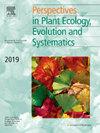Monitoring biodiversity in the global change era: The importance of herbaria and genetic diversity
IF 2.9
3区 环境科学与生态学
Q1 ECOLOGY
Perspectives in Plant Ecology Evolution and Systematics
Pub Date : 2025-03-11
DOI:10.1016/j.ppees.2025.125862
引用次数: 0
Abstract
Climate change is having far-reaching consequences on all living beings, altering ecosystems, habitats, and biodiversity worldwide. Species distributions are shifting or decreasing, with alpine plant species being particularly threatened. Natural population monitoring allows the assessment of the impact of human-induced global changes. However, traditional monitoring strategies based on individual counts may produce delayed signals of biodiversity loss. These approaches overlook the fact that genetic diversity is the fundamental basis for evolutionary processes, as it enables populations to adapt to environmental changes, including those caused by climate change. Here, we draw attention to the use of genetic diversity in monitoring schemes to anticipate negative trends in biodiversity and propose two fundamental methodologies: genomics and the use of herbarium specimens. Firstly, in contrast to genetic markers conventionally used to quantify genetic diversity, such as microsatellite markers, genomic approaches provide a vast amount of data that does not require previous knowledge of the studied organism, making them suitable for the study of non-model species. Secondly, herbaria worldwide serve as excellent sources of plant material for comparative studies across time with their precise chronologically recorded collection data. The accuracy of genetic diversity estimates increases with sample size, therefore a large number of vouchers is ideally required. However, the availability of specimens from the same species and populations in public herbaria is limited. Different strategies to quantify genetic diversity are proposed depending on the number of specimens available and their geographic distribution. Finally, we illustrate the potential of this approach in the most restrictive scenario, where only a few individuals are available, and there is no conspecific reference genome. Even in this restrictive scenario, there are signs of genetic depauperation in an alpine species with a narrow distribution, but not in a widely distributed congeneric.
在全球变化时代监测生物多样性:植物标本馆和遗传多样性的重要性
气候变化正在对所有生物产生深远的影响,改变着全球的生态系统、栖息地和生物多样性。物种分布正在转移或减少,高山植物物种受到的威胁尤其严重。自然种群监测可以评估人类引起的全球变化的影响。然而,传统的基于个体计数的监测策略可能会产生生物多样性丧失的延迟信号。这些做法忽视了这样一个事实,即遗传多样性是进化过程的根本基础,因为它使人口能够适应环境变化,包括气候变化引起的环境变化。在此,我们提请注意遗传多样性在监测计划中的使用,以预测生物多样性的负面趋势,并提出两种基本方法:基因组学和植物标本馆标本的使用。首先,与传统上用于量化遗传多样性的遗传标记(如微卫星标记)相比,基因组方法提供了大量的数据,而这些数据不需要先前对所研究生物的了解,这使得它们适合于对非模式物种的研究。其次,世界各地的植物标本馆以其精确的年代记录的收集数据为跨时间比较研究提供了极好的植物材料来源。遗传多样性估计的准确性随着样本量的增加而增加,因此理想情况下需要大量的凭证。然而,公共植物标本室中来自同一物种和种群的标本是有限的。根据可获得的标本数量及其地理分布,提出了不同的量化遗传多样性的策略。最后,我们说明了这种方法在最受限制的情况下的潜力,在这种情况下,只有少数个体可用,并且没有同种参考基因组。即使在这种限制性情况下,在分布狭窄的高山物种中也有遗传缺失的迹象,而在分布广泛的同属物种中则没有。
本文章由计算机程序翻译,如有差异,请以英文原文为准。
求助全文
约1分钟内获得全文
求助全文
来源期刊
CiteScore
6.50
自引率
0.00%
发文量
28
审稿时长
67 days
期刊介绍:
Perspectives in Plant Ecology, Evolution and Systematics (PPEES) publishes outstanding and thought-provoking articles of general interest to an international readership in the fields of plant ecology, evolution and systematics. Of particular interest are longer, in-depth articles that provide a broad understanding of key topics in the field. There are six issues per year.
The following types of article will be considered:
Full length reviews
Essay reviews
Longer research articles
Meta-analyses
Foundational methodological or empirical papers from large consortia or long-term ecological research sites (LTER).

 求助内容:
求助内容: 应助结果提醒方式:
应助结果提醒方式:


